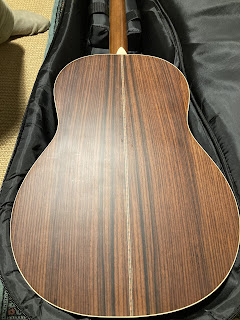The skill of luthiery is a very ancient one and is really still immensely important for classical stringed instruments such as the violin, not only in manufacture but in set up and maintenance.
The growing popularity of the guitar coincided with the mass production philosophies of early 20th Century factories, and this had a very big influence on how guitars were designed and built. Scaling up production lines meant the price of a guitar to the musician was incredibly cheap compared to other stringed instruments made in small luthier’s workshops.
While factory methods have been used very effectively throughout the recent history of the manufacture of guitars, and many small production luthiers now base their models on the standards of these guitars, it isn’t true to say that a factory built guitar is simply produced by a machine. They are not stamped out on an automated production line. Usually many of the steps to make a factory guitar are carried out by hand, while machinery is used to save time and labour in some of the processes. More recently CNC machines have really revolutionised some hugely labour intensive processes like cutting out, carving and fretwork. I have one of the first electric guitars produced using these methods, a Peavey T-60, it’s a beautifully finished guitar with lots of detail.
So hand building is perhaps a matter of degree. A company like Eastman, for example, still seem to do a lot of work by hand, whereas other companies may choose to automate much of their production line. However all guitar production will have a significant amount of hand working and finishing. Most individual luthiers will also of course use power tools and may choose to automate some of their production processes, but expensive machines, like a plek machine, only really make sense for a large production run.
So there’s not really a simple divide between automation and hand building. Nor is one necessarily better than the other. It’s worth noting that in some things machine accuracy is far greater than a human could ever achieve with hand tools. However in something like the selection of perfect matched wood or overall quality control, an experienced human eye is hard to beat. I’d prefer the money for labour to go primarily into specialist skills rather than into laborious tasks which can be done equally well or better by machine. Also, not many of us are good all rounders, a guitar requires a great many different skills to complete so there is perhaps some benefit in having different workers trained and focused on the different skill sets. Finishing a guitar for example is a very different skill to carving a top. A good luthier will have mastered all the different craft skills, but this takes a lifetime of learning and experience. However the advantage is that the luthier follows the whole process and artistry through and perhaps this gives the instrument a bit more soul and personality.
We should probably here draw a distinction between electric guitars and those designed primarily to be acoustic instruments.
An electric guitar benefits from individual luthiery primarily in the attention to detail and customisability and uniqueness. There are a huge number of variables once you start thinking about it, and it is wonderful to have something truly made to measure.
The acoustic guitar is arguably an instrument that is far harder to manufacture to both sound and look good. The luthier has to develop the skills to bring the finest tone out of the materials being used, and the work is often much more delicate.
The advantage of a small workshop luthiery is that you can talk to the luthier about what you want, and even present them with your old mantelpiece to work with, or specify very particular requirements. Custom shops in big factories might give a bit more choice to the standard models, but this is generally much more limited in scope unless you are a celebrity. A small workshop luthier probably has more flexibility to change the levels of hand detailing, but of course you can’t usually try before you buy, so you are putting a lot of trust as well as a lot of cash into the final deal. If you believe in the magic of tap tuning and the minuscule differences shaving mass off the braces of an acoustic guitar can make, then a luthier is probably the person to go to.
If I had the money I’d definitely be thinking of getting a local luthier to build me a guitar to my own specs. This isn’t because it will necessarily be better than a factory built one, but because it would be personal to me. I also love the fact that these people exist, they deserve to succeed. Even if you have a factory guitar, a good luthier can work wonders with set up and after market changes, additions and repairs. But having said that I have no issues with the lovely guitars I already own, most of which are largely hand built and finished, probably by many different skilled workers in a factory rather than a luthier or two in a small workshop.










